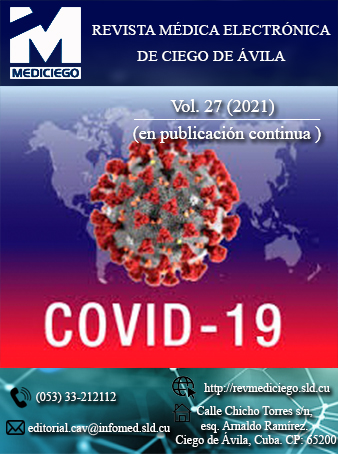Risk factors associated with intrauterine growth restriction in urban pregnant women in Ciego de Ávila municipality, 2016-2018
Abstract
Introduction: intrauterine growth restriction is a situation that adversely affects survival and neonatal life.
Objective: to identify maternal risk factors associated with intrauterine growth restriction in pregnant women in the urban sector of the Ciego de Ávila municipality.
Methods: a retrospective analytical study was carried out between January 2016 and April 2018.
The study universe consisted of 190 pregnant women with intrauterine growth restriction (cases) and a similar number of pregnant women without this condition (controls), matched 1:1, belonging to the same health area and in a similar period of time. The chi-square test of independence (Yates' correction for continuity) was used and, in the event of a significant result, the odds ratio was calculated to identify the magnitude of the association. The ethical precepts of the research were complied with.
Results: the risk of a short interpregnancy interval was 12 times higher in pregnant women who presented intrauterine growth retardation (OR: 12,309). The risks were followed by the mother's underweight nutritional status (23 times, OR: 0,02), insufficient maternal weight gain (17 times, OR: 16,972), History of chronic diseases (10 times, OR: 10,113), vaginal sepsis (nine times, OR: 8,7) and smoking (25 times, OR: 25,1).
Conclusions: the risk factors associated with intrauterine growth restriction in the urban sector pregnant women studied were: nutritional status, weight gain, short interpregnancy interval, chronic diseases, diseases associated with pregnancy and smokingDownloads
Published
How to Cite
Issue
Section
License
Those authors who have publications with this journal accept the following terms of the License CC Attribution-NonCommercial 4.0 International (CC BY-NC 4.0):
You are free to:
- Share — copy and redistribute the material in any medium or format
- Adapt — remix, transform, and build upon the material
The licensor cannot revoke these freedoms as long as you follow the license terms.
Under the following terms:
- Attribution — You must give appropriate credit , provide a link to the license, and indicate if changes were made . You may do so in any reasonable manner, but not in any way that suggests the licensor endorses you or your use.
- NonCommercial — You may not use the material for commercial purposes .
- No additional restrictions — You may not apply legal terms or technological measures that legally restrict others from doing anything the license permits.
The journal is not responsible for the opinions and concepts expressed in the works, which are the exclusive responsibility of the authors. The Editor, with the assistance of the Editorial Committee, reserves the right to suggest or request advisable or necessary modifications. Original scientific works are accepted for publication, as are the results of research of interest that have not been published or sent to another journal for the same purpose.
The mention of trademarks of specific equipment, instruments or materials is for identification purposes, and there is no promotional commitment in relation to them, neither by the authors nor by the editor.

























